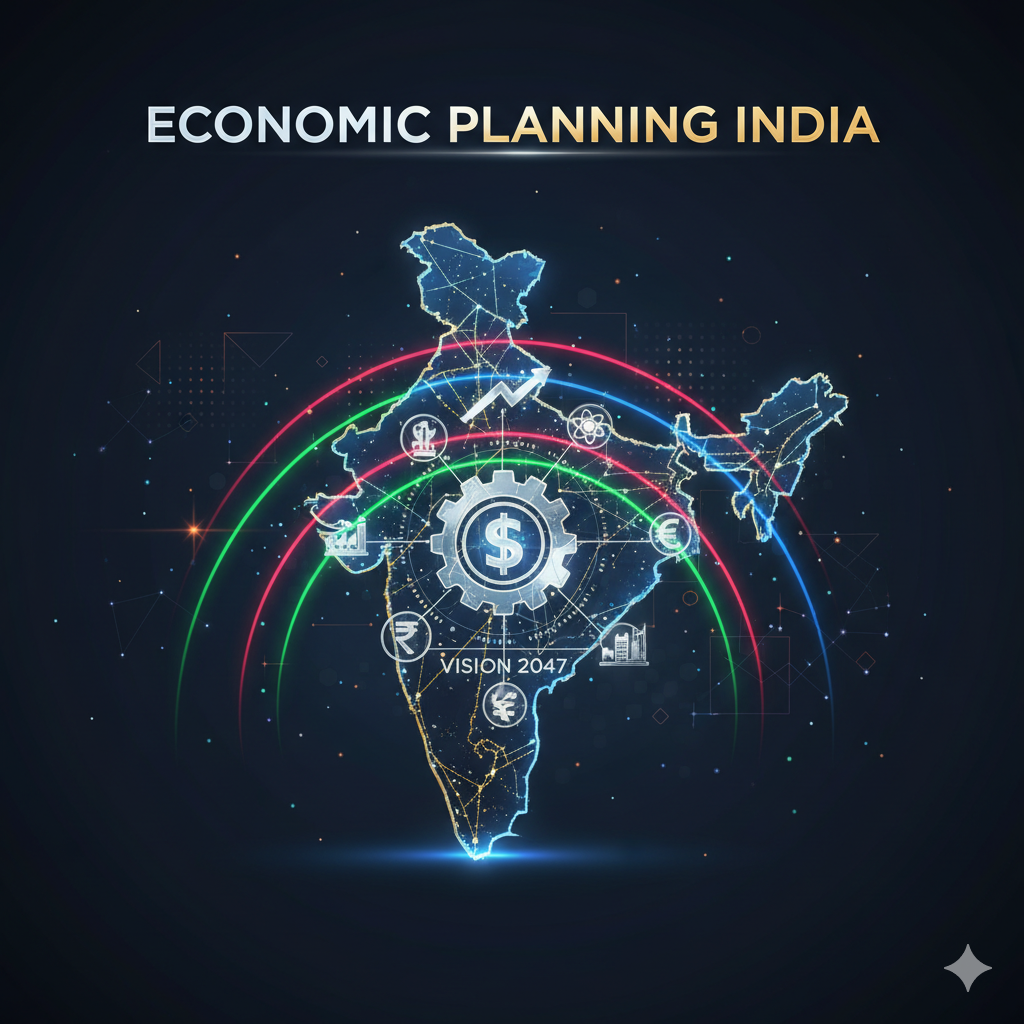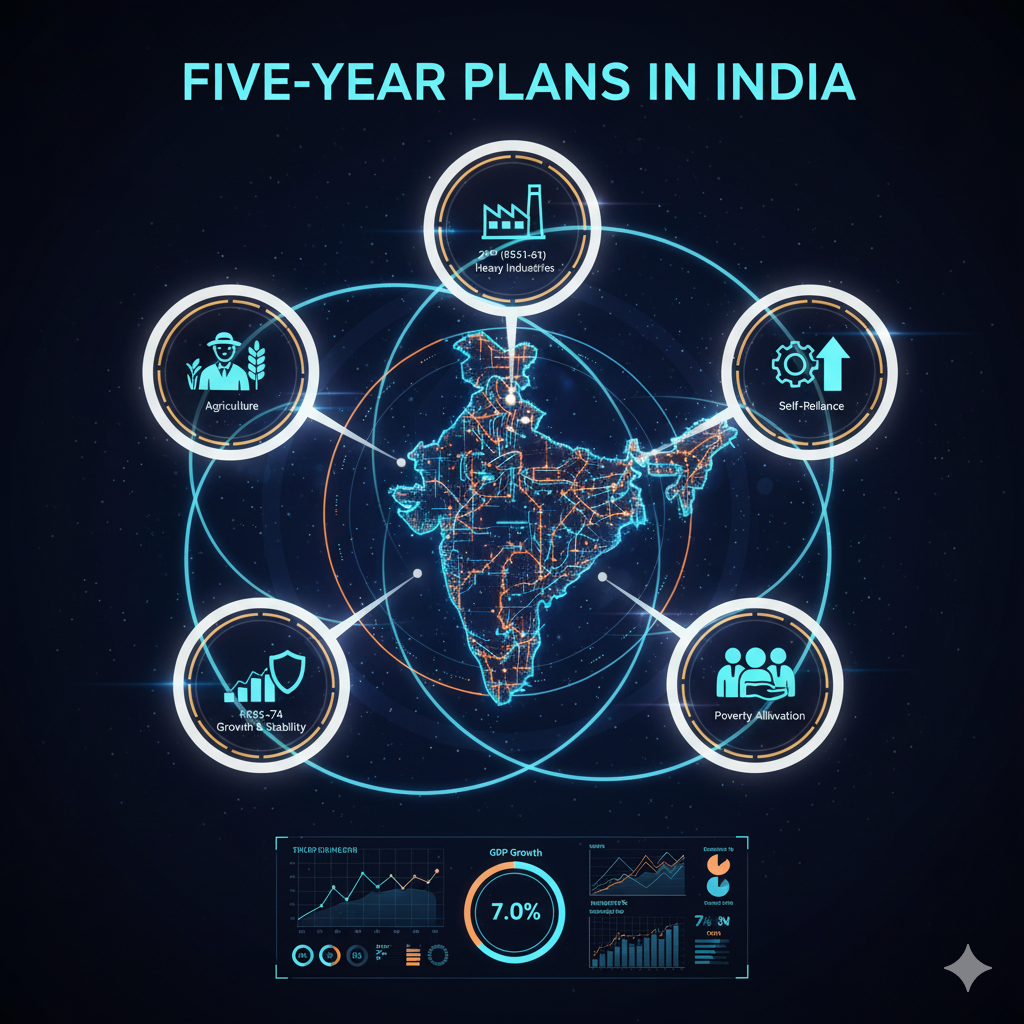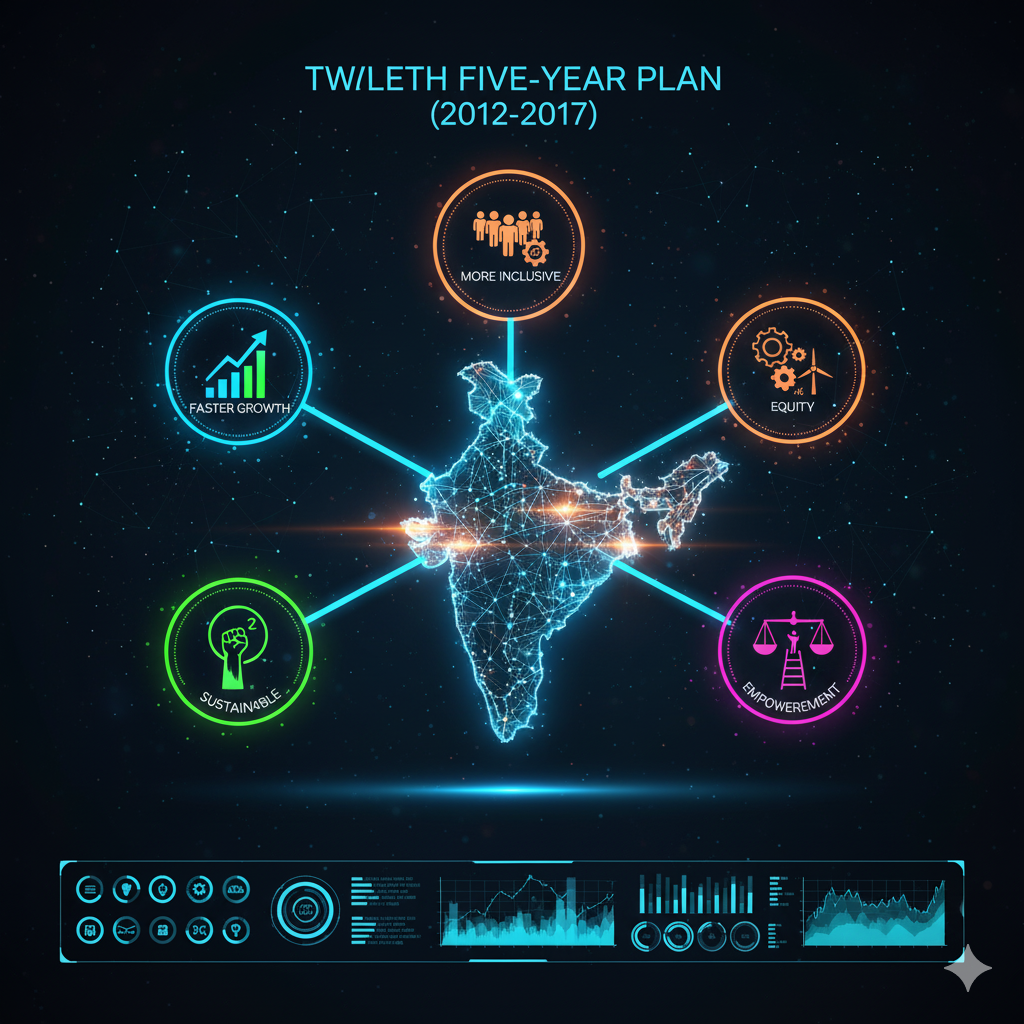Introduction
Economic planning in India has been one of the most significant pillars of the nation’s developmental journey after Independence. To ensure the systematic and balanced economic growth of a newly independent nation, the Government of India established institutional mechanisms that could formulate, implement, and monitor development strategies. Two such crucial institutions were the Planning Commission (1950) and the National Development Council (NDC) (1952).
Both bodies worked together to guide the process of economic planning, resource allocation, and coordination between the Centre and the States. While the Planning Commission prepared the plans, the NDC acted as a platform for cooperative federalism, approving and reviewing those plans.
What is the Planning Commission?
The Planning Commission was an apex advisory body constituted by the Government of India in March 1950, through an executive resolution of the Government, not by an act of Parliament. It was established to assess the country’s resources and formulate Five-Year Plans for the effective utilization of those resources for economic development.
It functioned under the chairmanship of the Prime Minister of India, symbolizing the importance the government attached to planning in the national agenda. The Commission played a crucial role in shaping India’s developmental priorities, industrial policies, and allocation of resources for nearly six decades.
Historical Background
After Independence in 1947, India faced numerous challenges — poverty, unemployment, food shortages, low industrial output, and inadequate infrastructure. The government realized that planned economic development was necessary to ensure equitable distribution of wealth and sustainable growth.
The idea of planning was not entirely new to India. The Bombay Plan (1944) and the People’s Plan (1945) had earlier proposed planned development. However, these were only conceptual efforts. The real institutional foundation for planning was laid with the establishment of the Planning Commission in 1950, following the adoption of the Directive Principles of State Policy enshrined in the Constitution, which emphasized the state’s responsibility for social and economic welfare.
Composition of the Planning Commission
The Planning Commission was a non-constitutional and non-statutory body. It derived its authority directly from the Union Government. Its composition generally included:
- Chairman: The Prime Minister of India.
- Deputy Chairman: Appointed by the Prime Minister; usually a distinguished economist or political leader.
- Full-time Members: Experts in various fields like economics, industry, agriculture, social services, and education.
- Part-time Members: Cabinet Ministers nominated by the Prime Minister.
- Member Secretary: A senior government official responsible for administration and coordination within the Commission.
Objectives of the Planning Commission
The primary objectives of the Planning Commission were to:
- Assess National Resources: Evaluate the physical, capital, and human resources of the country and estimate the potential for their development.
- Formulate Five-Year Plans: Design short-term and long-term plans to achieve balanced and sustainable economic growth.
- Prioritize Needs: Identify and prioritize sectors critical for development — such as agriculture, industry, transport, and energy.
- Coordinate Implementation: Ensure coordination among various ministries and between the Centre and States for effective execution.
- Promote Social Justice: Reduce inequalities of income, wealth, and opportunity across regions and communities.
- Encourage Self-Reliance: Focus on developing indigenous capabilities to reduce dependence on foreign aid.
- Achieve Economic Stability: Control inflation, unemployment, and trade imbalances through planned interventions.
Functions of the Planning Commission
The Commission performed several important functions in India’s economic planning process:
- Resource Assessment and Allocation: It analyzed the country’s available resources and decided on their optimal utilization among different sectors.
- Formulation of Plans: The Commission prepared Five-Year Plans, Annual Plans, and Special Area Development Programs.
- Policy Advisory Role: It advised the government on economic policies, industrial growth, and social welfare schemes.
- Coordination Among Ministries: Ensured harmony among ministries and departments in executing plan targets.
- Review and Evaluation: Monitored the progress of ongoing plans and suggested corrective measures.
- Promotion of Research: Encouraged studies, data collection, and pilot projects related to economic development.
- Balanced Regional Development: Focused on reducing disparities between developed and backward regions.
Five-Year Plans by the Planning Commission
The Planning Commission introduced Five-Year Plans in 1951, inspired by the Soviet model of centralized planning. Each plan focused on specific objectives and sectors:
| Plan | Period | Focus/Objective |
|---|---|---|
| First Plan | 1951–56 | Agriculture and irrigation development |
| Second Plan | 1956–61 | Industrialization and Mahalanobis model |
| Third Plan | 1961–66 | Self-reliance and economic stability |
| Fourth Plan | 1969–74 | Growth with stability and progress toward socialism |
| Fifth Plan | 1974–79 | Removal of poverty (Garibi Hatao) |
| Sixth Plan | 1980–85 | Poverty alleviation and employment |
| Seventh Plan | 1985–90 | Modernization and technology upgradation |
| Eighth Plan | 1992–97 | Human resource development post-LPG reforms |
| Ninth Plan | 1997–2002 | Inclusive growth and equity |
| Tenth Plan | 2002–07 | Targeting 8% growth rate |
| Eleventh Plan | 2007–12 | Inclusive and sustainable growth |
| Twelfth Plan | 2012–17 | Faster, sustainable, and inclusive growth |
(Note: After 2014, Five-Year Plans were discontinued and replaced by the NITI Aayog approach.)
What is the National Development Council (NDC)?
The National Development Council (NDC), also known as the Rashtriya Vikas Parishad, was established on 6 August 1952. It served as the apex body for decision-making and coordination between the Central Government, State Governments, and the Planning Commission.
The NDC was not a constitutional or statutory body, but it played a vital role in ensuring cooperative federalism — aligning the development priorities of the Centre and States.
Composition of NDC
The NDC consisted of:
- Prime Minister of India (Chairperson)
- Union Cabinet Ministers
- Chief Ministers of all States and Union Territories
- Administrators of Union Territories
- Members of the Planning Commission
This inclusive composition made NDC a truly representative body reflecting India’s federal democratic structure.
Objectives of NDC
The key objectives of the NDC were to:
- Strengthen Cooperative Federalism: Provide a platform for the Centre and States to jointly discuss developmental policies.
- Approve National Plans: Examine and approve draft Five-Year Plans prepared by the Planning Commission.
- Review Implementation: Evaluate the performance of plans and suggest necessary modifications.
- Promote Balanced Development: Ensure that planning efforts benefited all regions and communities.
- Ensure Political and Administrative Coordination: Bring consensus between the Centre and States on developmental priorities.
- Mobilize Resources: Identify ways to finance and mobilize resources for plan implementation.
Functions of the National Development Council
- Approval of Plans: The NDC reviewed and approved the draft Five-Year Plans and ensured they aligned with national objectives.
- Review of Progress: Periodically assessed the progress of plan implementation at both central and state levels.
- Coordination Mechanism: Worked as a bridge between the Planning Commission and the State Governments.
- Guidance for Policy Making: Suggested reforms to improve the effectiveness of planning and development programs.
- Promotion of Cooperative Federalism: Enabled both levels of government to share responsibilities in economic development.
- Setting National Priorities: Decided key focus areas like poverty alleviation, employment generation, or infrastructure development.
- Encouragement of Regional Balance: Addressed regional disparities by involving state representatives directly in the planning process.
Significance of NDC in Indian Planning
- Strengthening Democracy: The NDC represented an institutional mechanism for participatory decision-making.
- Ensuring Unity in Policy: Helped align the economic goals of the Centre and the States.
- Policy Flexibility: Provided feedback to adjust plans according to ground realities.
- Institutionalizing Federalism: Enhanced intergovernmental cooperation, especially in resource allocation.
- Improving Plan Efficiency: By including state leaders, plans were better implemented at local levels.

Relationship Between the Planning Commission and NDC
The Planning Commission and the National Development Council were complementary institutions in India’s planning system.
- The Planning Commission prepared the draft plans.
- The NDC approved, reviewed, and coordinated the implementation of these plans with the states.
Thus, the Planning Commission was a technical and policy-making body, whereas the NDC was a political and coordination body ensuring democratic participation in planning.
Decline of the Planning Commission and NDC
By the early 21st century, India’s economic structure and governance needs had changed significantly. The Liberalization, Privatization, and Globalization (LPG) reforms of 1991 shifted the economy toward market-based mechanisms, reducing the need for centralized control.
Several criticisms were raised against the Planning Commission:
- Over-centralization of power.
- Lack of coordination with states.
- Rigid and outdated planning approach.
- Poor adaptability to changing global economic trends.
To address these challenges, in January 2015, the Government of India abolished the Planning Commission and replaced it with a new institution — the NITI Aayog (National Institution for Transforming India).
The NITI Aayog adopted a bottom-up approach focusing on cooperative and competitive federalism. Consequently, the National Development Council also became inactive since its functions were absorbed into the new framework.
Comparison: Planning Commission vs. NITI Aayog
| Aspect | Planning Commission | NITI Aayog |
|---|---|---|
| Established | 1950 | 2015 |
| Nature | Centralized Planning Body | Think Tank and Policy Advisory Body |
| Approach | Top-down | Bottom-up |
| Legal Status | Non-statutory | Non-statutory |
| Focus | Formulation of Five-Year Plans | Sustainable and Inclusive Development |
| Chairperson | Prime Minister | Prime Minister |
| Role of States | Consultative | Collaborative and Participatory |
| Objective | Economic Planning and Allocation | Policy Formulation, Innovation, and Implementation |
Conclusion
The Planning Commission and the National Development Council played foundational roles in shaping India’s post-independence development trajectory. For over six decades, they guided the nation’s planning process, coordinated between the Centre and States, and ensured resource allocation to critical sectors.
While the Planning Commission provided the technical framework and formulated the plans, the NDC gave them political legitimacy and fostered cooperative federalism.
However, with changing economic realities and the need for greater flexibility, India transitioned from centralized planning to a more participatory and adaptive policy mechanism through NITI Aayog. Nevertheless, the legacy of the Planning Commission and NDC remains vital, as they laid the institutional foundation for India’s economic modernization and development governance.




